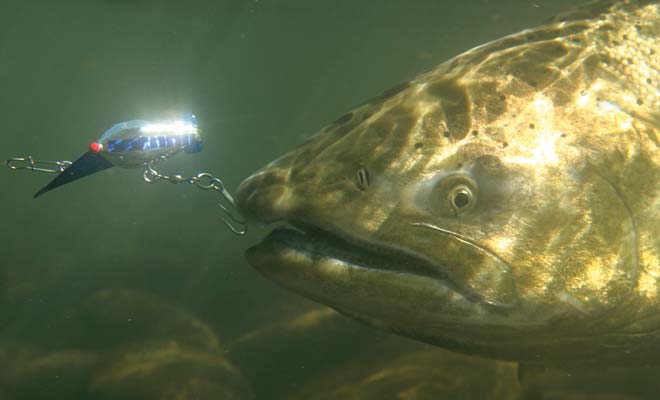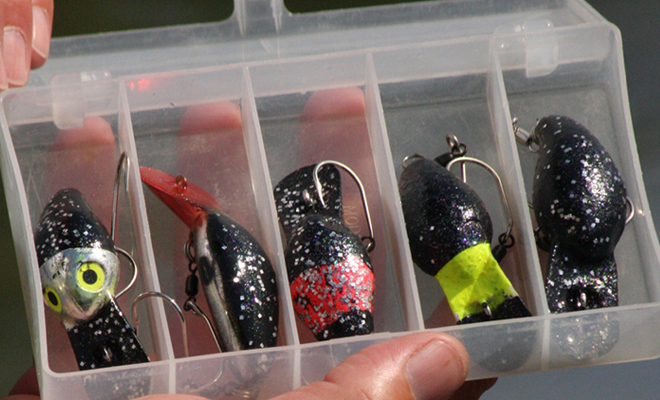
Story & Photos by Scott Haugen
Whether fished from a sled, drift boat, pontoon setup or off the bank with a side-planer, there’s no doubting the power of plug fishing when targeting salmon. In Alaska, plugs dominate not only many of the salmon fisheries, but are very effective when it comes to catching steelhead and trophy-sized rainbows as well.
Plugs can be fished by way of back-trolling, casting and retrieving, even by plunking and back-bouncing. While the peak of plug fishing spiked in the latter part of the 1980s, there’s no question plug fishing continues to help anglers broaden their horizons and catch more fish. [emember_protected custom_msg=’This content is available for subscribers only.’]
More than ever, salmon, steelhead and trout anglers have at their disposal a growing selection of plugs to choose from. Plugs now come in an array of sizes, shapes and colors. Some have rattles inside, some have lights. Some glow, some have scent chambers. As for color selections, never have there been so many options, though the color you’re searching for may not always be easy to find.

In an effort to attain the ideal color combination for the species and rivers they fish, some anglers have mastered the art of airbrushing their own plugs. No question, these customized plugs are some of the most stunning you’ll lay eyes on, and they catch fish. But, if you’re looking to change or add color to your plugs, it’s not necessary to invest in an airbrush, paints and all the fancy gadgets associated with this art form.
I’ve only briefly played around with airbrushing, and quickly found I didn’t have the time or patience to take it to the next level. Instead, I stuck with what I learned at an early age, and that’s how to quickly alter my plug colors at little or no cost. The approach is simple and can be done in three ways, and they all work.
For as long as I can remember, my dad always had a red permanent marker in his tackle box. With it he’d color the bill and/or tail of a silver plug, and that was it.
As years passed and permanent markers grew in color selection, soon blue, then green made it into our tackle boxes. Today, those colors still play an integral role in our fish-catching ability. Dad rarely runs a Hot Shot unless it’s his favorite silver with the homemade red head.
By coloring the bill, tail, even putting a stripe down each side of a plug, you’re allowing incoming sunlight to be reflected in various colors. It’s this kind of variety that can result in boosting strike rates.
On larger plugs like KwikFish, you can color on dots or various line patterns. The increased surface area of these plugs allows more color to be added, which can increase the color combinations being reflected.

Colored tape can also be added. Luhr Jensen makes a beautiful colored tape with a striking, prism-like reflective pattern that comes in small sheets. These sheets can be cut with scissors and trimmed to fit and stick on any plug. The result is a highly reflective color that throws light very well with the sole intention of capturing the attention of fish.
When using tape on your plugs—or before putting any color on them—be sure the plugs are clean to begin with. Using an old toothbrush and warm, soapy water, get that plug as sparkling clean as possible. Avoid submerging the plugs in extremely hot water, as you don’t want any part of them to melt or become misshapen.
Once the plug is clean and dry, add your colors, be it with permanent marker or tape. Another way to add color is with glitter, which is easily attained at a craft store. Red, blue and green are the most popular colors to add to silver plugs. You can also add different colored glitter to already-colored plugs, like red glitter on a blue plug.
To add glitter to a plug, simply spray a thin layer of clear topcoat, and then sprinkle on the glitter. Be careful not to apply too much glitter, as the idea is to add just a touch of color, not cover the plug. Once it dries, spray one more thin topcoat layer to ensure the glitter is held in place.
When fishing clear waters on bright, sunny days, try going with a black plug topped with silver glitter. This is an option that sometimes works when the bright, flashy presentations aren’t producing.
To create black plugs, simply remove the hooks from your plug of choice, spray-paint it with flat-black, sprinkle some silver glitter on and let air dry. Once dry, spray a clear topcoat over the plug to hold the glitter in place, and let dry. Reattach the hooks and you’re set.
Once on the water, make sure your plug is tuned, that is, running in a straight line, as sometimes adding weight in the form or paint, tape and/or glitter can cause it to veer to one side. Simply run out eight- to ten feet of line then quickly pull the plug so it dives down. If it pulls to one side or the other, turn the eye-screw on the plug and test it again. Keep making minute adjustments until the plug runs true.
If you’re one who is looking to dabble a bit in adding color to your plugs, don’t feel like you have to buy the best airbrush system on the market in order to catch fish. You may not even need to invest in many new, shiny silver plugs, as you can clean and repaint older ones, or cover scarred plugs with reflective tape.
With a bit of creativity you’ll be surprised at how quickly you can change the appearance of a plug. The biggest reward, however, comes when you start catching more fish.
###
For signed copies of Scott Haugen’s latest book, Bank Fishing for Steelhead & Salmon, send a check for $17 (free S&H) to Haugen Enterprises, P.O. Box 275, Walterville, OR 97489. This and other how-to books, including cookbooks, can be ordered online at www.scotthaugen.com. [/emember_protected] [emember_protected scope=”not_logged_in_users_only”]
- Need to subscribe? Now’s a good time! Check out our current subscription specials!
- Already a subscriber? Login below to access all of our online articles and content!

